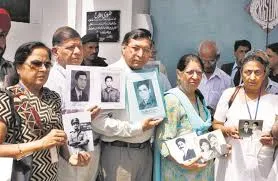Islamabad and New Delhi have exchanged the list of prisoners in each other's custody and details of nuclear installations, said Pakistan's Foreign Office on Saturday, adding that the practice has been ongoing since 1992.
In a press release, the Foreign Office (FO) said that the list was changed in accordance with Article-II of the Agreement on Prohibition of Attacks against Nuclear Installations and Facilities between Pakistan and India, signed on December 31, 1988 and ratified on January 27, 1991.
This practice has been followed consecutively since January 1, 1992, the statement added.
"The list of nuclear installations and facilities in Pakistan was officially handed over to a representative of the Indian High Commission at the Ministry of Foreign Affairs today, at 1030 hours (PST)," FO said
The statement further said that the Indian Ministry of External Affairs in New Delhi handed over the list of Indian nuclear installations and facilities to a representative of the Pakistan High Commission at 1100 hours (IST).
"The agreement provides, inter alia, that both countries should inform each other of their Nuclear Installations and Facilities within the definition of the Agreement on 1st January of each calendar year," FO added.
Maintaining the 31-year-old tradition, India and Pakistan have exchanged their lists of nuclear installations and civilian prisoners recently. But the list finds no mention of 54 Indian prisoners of war (POWs) who have been languishing in Pakistan jails for decades, leaving their kin a dejected lot once again. The Pakistani list includes only 55 Indian civilian prisoners and 227 fishermen.
Every time both governments exchange prisoners or take up confidence-building measures, a new hope emerges among such families.
Following Wing Commander Abhinandan’s release, even Punjab Chief Minister Capt Amarinder Singh had urged Pakistan to release these POWs, but in vain. Though Pakistani never admitted about the capture of any such Indian Army man, there have been facts which substantiate the claims of their kin.“Had Pakistani civilians not recorded video of Wing Commander Abhinandan while he was being nabbed in Horran village, which went viral, his fate might have been different,” said Brig Navdeep Mathur (retd), adding that India released over 9,000 of Pakistani after the 1971 war, but could not get its 54.
Several civilians and spies, who returned from Pakistan jails, have spoken of meeting those missing defence personnel.Talking to The Tribune, Satish Kumar of Ferozepur, who remained in Kot Lakhpat Jail, Lahore, for spying, said he met several Indian POWs. “Around 30 or 40 POWs are in the jails of Lahore, Quetta and Rawalpindi. Of them, many have lost their sanity after years of torture and confinement,” he said.
A Pakistani newspaper, Sunday Observer, wrote on December 5, 1971 that five Indian pilots had been captured alive, one of them being Flt-Lt Tombay (Tambay). Time magazine, in its December 27, 1971 issue, carried a picture of Indian soldiers behind bars in Pakistan, including one Major AK Ghosh.In 1975, Major Ashok Suri managed to send a letter from Karachi jail to his father in which he wrote that about 20 Indian officers were in Pakistani jails.
In 1983, a delegation of the relatives of six missing Indian POWs was sent to Pakistan to identify them among the Indian detainees but the Pakistani authorities refused to show all in their custody. In 1988, a book penned by a British woman, Victoria Schoffield, titled ‘Bhutto: Trial and Execution’ mentiond about Indian POWs in Kot Lakhpat jail close to where Zulfikar Ali Bhutto was kept in solitary confinement.The matter has been raised a number of times in the Indian Parliament, reminders have been sent to the United Nations and the International Red Cross Society, but to no avail.
Dr Simmi Waraich, whose father was taken as POW from Ferozepur in 1971, has demanded that the government should open a separate cell in the Ministry of External Affairs to deal with such cases. She also sought from the defence ministry to have a separate category for ‘missing in action’ personnel and a proper desk which can make efforts to bring them back.

